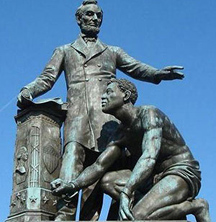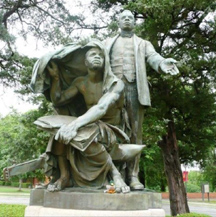A swath of historians and poets met protesters who have been demanding the removal of the Abraham Lincoln statue in Washington, DC. Former enslaved Africans funded the statue, the first ever built of Lincoln to symbolize his role in ending slavery in the U.S., according to the National Park Service.
Some critics of the monument point to Frederick Douglass’ Oration in Memory of Abraham Lincoln as proof of his disapproval of the Lincoln statue. In his speech delivered April 14, 1876 at the unveiling of The Freedmen’s Monument in Lincoln Park, he said of Lincoln, “He was preeminently the White man’s President, entirely devoted to the welfare of White men. He was ready and willing at any time during the first years of his administration to deny, postpone, and sacrifice the rights of humanity in the Colored people to promote the welfare of the White people of this country.”
People who are not “flawed” don’t exist, cautioned spoken word artist Nathan Richardson, who has been a Frederick Douglass reenactor for six years. The Hampton, Virginia resident says both men are much more complex than the general narrative and that Lincoln was much like President Lyndon Baines Johnson (LBJ).
He explained, “Lincoln had racist tendencies and a conscience to overcome those racist tendencies. LBJ had racist tendencies just like Lincoln, but he also had a conscience that overcome those racist tendencies and only he could go into the backroom with other racists and ask them to come along and move history forward.”
In the same 1876 speech, the real Douglass seems to express a similar thought. “Though he (Lincoln) loved Caesar less than Rome, though the Union was more to him than our freedom or our future, under his wise and beneficent rule we saw ourselves gradually lifted from the depths of slavery to the heights of liberty and manhood; under his wise and beneficent rule.”
Douglass explained the complexity of trying to create a one dimensional view of a person, nevertheless an image, in a 1876 speech.
However, 2018 and current DC Council At-Large candidate Marcus Goodwin insists “It’s time to take down monuments that memorialize the intended subservience of Black people in this country. Confederate statues are the obvious example, but this statue in Washington, DC perpetuates the idea that we are beneath White people and should simply be grateful for the scraps that have been thrown our way.”
Classic literature educator Carolivia Herron says she felt the anger of some protestors and the “intensity of their dislike of the statue.” She added, “I too have a problem with the statue, but in an ideal world, I would have it there with a call-and-response exhibit of some sort that will provide a fuller story.”
Noting that in their day, Douglass and Lincoln faced adversarial crowds, John Muller, organized the living historians’ educational protest. Mueller, who also organizes Frederick Douglass presentations and walking tours, added, “The purpose of the event was to return the history of the community to the community and give elders an opportunity to guard and preserve the history in the park.”
Peter Hanes, who is a distant relative of Solomon Brown, who was on the 1876 committee celebrating the installation of the Lincoln statue, and whose mother, Loretta Carter Hanes, led the revival of the celebration of DC Emancipation Day, says Lincoln Park has been the site of DC Emancipation celebrations and other Black history programs over the years. “I want it to remain there, but I know it needs to come down, but come down with dignity and be placed in a place of respect like a museum.”
Living Historians “Take Back the Park”


However, the different of opinions in the larger community is being reflected at Port Of Harlem. The magazine’s contributor and historian CR Gibbs (The Great Influenza Pandemic of 1918, the Nation’s Capital, and the Making of Charles Drew by Gibbs in this current issue) takes a slightly different position than that of fellow historian and frequent Port Of Harlem contributor Ida Jones. “Given all the Black history behind it, the statue should be either modified or moved to a museum where it can be properly interpreted and its past better known,” Gibbs says.
Jones, University Archivist, Morgan State University, is not a proponent to wantonly removing controversial statutes including that of Lincoln in Lincoln Park and Confederate memorials on public property or those paid for with public funds. Jones, who is an active member of Carter G. Woodson’s Association for the Study of African American Life and History, says, “We need to contextualize the Lincoln and other memorials and live in concert with our past in full view of those actors who participated.”
Just as the House was passing the historic DC Statehood bill that will allow Washington, D.C. to become the 51st state, called the Douglass Commonwealth, partially after Frederick Douglass, DC’s non-voting delegate to the U.S. Congress introduced legislation to remove the Andrew Jackson statue from Lafayette Park and the Emancipation Statue in Lincoln Park, both in the nation’s capital.
"The designers of the Emancipation Statue in Lincoln Park in DC didn't take into account the views of African Americans. It shows," Norton tweeted. "Blacks too fought to end enslavement. That's why I'm introducing a bill to move this statue to a museum." However, the delegate said the statue is on National Park Service land, and she would first work to see if they could remove the statue without an act of Congress.
Muller hopes an informed discussion will continue on the complexities of the statue and what it represents to various people, including elders.
Douglass himself explained the complexities of trying to create a one dimensional view of a person, nevertheless an image, in the 1876 speech he clarified: "Had he put the abolition of slavery before the salvation of the Union, he would have inevitably driven from him a powerful class of the American people and rendered resistance to rebellion impossible. Viewed from the genuine abolition ground, Mr. Lincoln seemed tardy, cold, dull, and indifferent; but measuring him by the sentiment of his country, a sentiment he was bound as a statesman to consult, he was swift, zealous, radical, and determined."
Note: Monumental Changes? The Debate Over Local Statues, 30 minutes, The Kojo Nnamdi Show – WAMU-FM-DC, featuring Margaret Barthel WAMU Transportation Reporter, Justin Wilson Mayor, Alexandria, VA (D), and Ida Jones, University Archivist, Morgan State University
New Yorker Cedric Davis Expresses Outrage (Facebook video)
Muhammad Ali’s DNA Ancestry Linked to Escaped Slave (depicted on Emancipation Memorial)
A copy of the Lincoln statue is also installed in Boston, home to the statue's creator Thomas Ball.
Historians, Washingtonians & Douglassonians Take Back Lincoln Park
Lincoln Park
1100 East Capitol Street, SE
Washington, DC
Fri, Jul 3, 6:30p–8p
Jones, University Archivist, Morgan State University, is not a proponent to wantonly removing controversial statutes including that of Lincoln in Lincoln Park and Confederate memorials on public property or those paid for with public funds. Jones, who is an active member of Carter G. Woodson’s Association for the Study of African American Life and History, says, “We need to contextualize the Lincoln and other memorials and live in concert with our past in full view of those actors who participated.”
“I too have a problem with the statue, but in an ideal world, I would have it there with a call-and-response exhibit of some sort that will provide a fuller story.”
-Classic literature educator Carolivia HerronJust as the House was passing the historic DC Statehood bill that will allow Washington, D.C. to become the 51st state, called the Douglass Commonwealth, partially after Frederick Douglass, DC’s non-voting delegate to the U.S. Congress introduced legislation to remove the Andrew Jackson statue from Lafayette Park and the Emancipation Statue in Lincoln Park, both in the nation’s capital.
"The designers of the Emancipation Statue in Lincoln Park in DC didn't take into account the views of African Americans. It shows," Norton tweeted. "Blacks too fought to end enslavement. That's why I'm introducing a bill to move this statue to a museum." However, the delegate said the statue is on National Park Service land, and she would first work to see if they could remove the statue without an act of Congress.
Muller hopes an informed discussion will continue on the complexities of the statue and what it represents to various people, including elders.
Douglass himself explained the complexities of trying to create a one dimensional view of a person, nevertheless an image, in the 1876 speech he clarified: "Had he put the abolition of slavery before the salvation of the Union, he would have inevitably driven from him a powerful class of the American people and rendered resistance to rebellion impossible. Viewed from the genuine abolition ground, Mr. Lincoln seemed tardy, cold, dull, and indifferent; but measuring him by the sentiment of his country, a sentiment he was bound as a statesman to consult, he was swift, zealous, radical, and determined."
Note: Monumental Changes? The Debate Over Local Statues, 30 minutes, The Kojo Nnamdi Show – WAMU-FM-DC, featuring Margaret Barthel WAMU Transportation Reporter, Justin Wilson Mayor, Alexandria, VA (D), and Ida Jones, University Archivist, Morgan State University
New Yorker Cedric Davis Expresses Outrage (Facebook video)
Muhammad Ali’s DNA Ancestry Linked to Escaped Slave (depicted on Emancipation Memorial)
A copy of the Lincoln statue is also installed in Boston, home to the statue's creator Thomas Ball.
Historians, Washingtonians & Douglassonians Take Back Lincoln Park
Lincoln Park
1100 East Capitol Street, SE
Washington, DC
Fri, Jul 3, 6:30p–8p
Advertisers | Contact Us | Events | Links | Media Kit | Our Company | Payments Pier
Press Room | Print Cover Stories Archives | Electronic Issues and Talk Radio Archives | Writer's Guidelines






